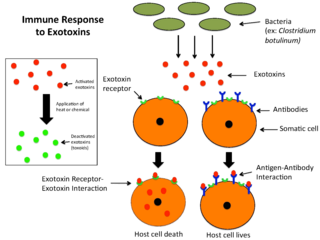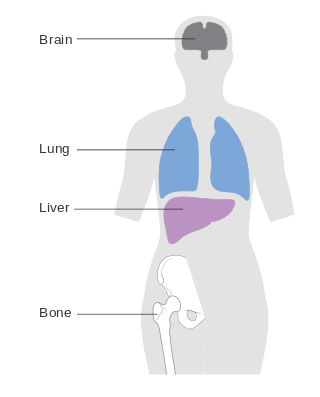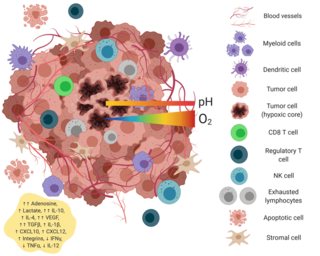Related Research Articles

Metastasis is a pathogenic agent's spread from an initial or primary site to a different or secondary site within the host's body; the term is typically used when referring to metastasis by a cancerous tumor. The newly pathological sites, then, are metastases (mets). It is generally distinguished from cancer invasion, which is the direct extension and penetration by cancer cells into neighboring tissues.

An exotoxin is a toxin secreted by bacteria. An exotoxin can cause damage to the host by destroying cells or disrupting normal cellular metabolism. They are highly potent and can cause major damage to the host. Exotoxins may be secreted, or, similar to endotoxins, may be released during lysis of the cell. Gram negative pathogens may secrete outer membrane vesicles containing lipopolysaccharide endotoxin and some virulence proteins in the bounding membrane along with some other toxins as intra-vesicular contents, thus adding a previously unforeseen dimension to the well-known eukaryote process of membrane vesicle trafficking, which is quite active at the host–pathogen interface.
An antimetabolite is a chemical that inhibits the use of a metabolite, which is another chemical that is part of normal metabolism. Such substances are often similar in structure to the metabolite that they interfere with, such as the antifolates that interfere with the use of folic acid; thus, competitive inhibition can occur, and the presence of antimetabolites can have toxic effects on cells, such as halting cell growth and cell division, so these compounds are used in chemotherapy for cancer.
The epithelial–mesenchymal transition (EMT) is a process by which epithelial cells lose their cell polarity and cell–cell adhesion, and gain migratory and invasive properties to become mesenchymal stem cells; these are multipotent stromal cells that can differentiate into a variety of cell types. EMT is essential for numerous developmental processes including mesoderm formation and neural tube formation. EMT has also been shown to occur in wound healing, in organ fibrosis and in the initiation of metastasis in cancer progression.

Matrilysin also known as matrix metalloproteinase-7 (MMP-7), pump-1 protease (PUMP-1), or uterine metalloproteinase is an enzyme in humans that is encoded by the MMP7 gene. The enzyme has also been known as matrin, putative metalloproteinase-1, matrix metalloproteinase pump 1, PUMP-1 proteinase, PUMP, metalloproteinase pump-1, putative metalloproteinase, MMP). Human MMP-7 has a molecular weight around 30 kDa.

B-cell lymphoma 3-encoded protein is a protein that in humans is encoded by the BCL3 gene.

Heparanase, also known as HPSE, is an enzyme that acts both at the cell-surface and within the extracellular matrix to degrade polymeric heparan sulfate molecules into shorter chain length oligosaccharides.
The perinucleolar compartment (PNC) is a subnuclear body characterized by its location at the periphery of the nucleolus. The PNC participates in the patterned compartmentalization inside the nucleus to organize the specialized functions. It is almost exclusively found in oncogenic cells and enriched with RNA binding proteins as well as RNA polymerase III transcripts.

RhoC is a small signaling G protein, and is a member of the Rac subfamily of the family Rho family of GTPases. It is encoded by the gene RHOC.

S100 calcium-binding protein A11 (S100A11) is a protein that in humans is encoded by the S100A11 gene.
A metastasis suppressor is a protein that acts to slow or prevent metastases from spreading in the body of an organism with cancer. Metastasis is one of the most lethal cancer processes. This process is responsible for about ninety percent of human cancer deaths. Proteins that act to slow or prevent metastases are different from those that act to suppress tumor growth. Genes for about a dozen such proteins are known in humans and other animals.

Metastasis-associated protein MTA3 is a protein that in humans is encoded by the MTA3 gene. MTA3 protein localizes in the nucleus as well as in other cellular compartments MTA3 is a component of the nucleosome remodeling and deacetylate (NuRD) complex and participates in gene expression. The expression pattern of MTA3 is opposite to that of MTA1 and MTA2 during mammary gland tumorigenesis. However, MTA3 is also overexpressed in a variety of human cancers.

Carcinoembryonic antigen-related cell adhesion molecule 5 (CEACAM5) also known as CD66e, is a member of the carcinoembryonic antigen (CEA) gene family.
The MRN complex is a protein complex consisting of Mre11, Rad50 and Nbs1. In eukaryotes, the MRN/X complex plays an important role in the initial processing of double-strand DNA breaks prior to repair by homologous recombination or non-homologous end joining. The MRN complex binds avidly to double-strand breaks both in vitro and in vivo and may serve to tether broken ends prior to repair by non-homologous end joining or to initiate DNA end resection prior to repair by homologous recombination. The MRN complex also participates in activating the checkpoint kinase ATM in response to DNA damage. Production of short single-strand oligonucleotides by Mre11 endonuclease activity has been implicated in ATM activation by the MRN complex.
Microbial toxins are toxins produced by micro-organisms, including bacteria, fungi, protozoa, dinoflagellates, and viruses. Many microbial toxins promote infection and disease by directly damaging host tissues and by disabling the immune system. Endotoxins most commonly refer to the lipopolysaccharide (LPS) or lipooligosaccharide (LOS) that are in the outer plasma membrane of Gram-negative bacteria. The botulinum toxin, which is primarily produced by Clostridium botulinum and less frequently by other Clostridium species, is the most toxic substance known in the world. However, microbial toxins also have important uses in medical science and research. Currently, new methods of detecting bacterial toxins are being developed to better isolate and understand these toxins. Potential applications of toxin research include combating microbial virulence, the development of novel anticancer drugs and other medicines, and the use of toxins as tools in neurobiology and cellular biology.

Metastatic breast cancer, also referred to as metastases, advanced breast cancer, secondary tumors, secondaries or stage IV breast cancer, is a stage of breast cancer where the breast cancer cells have spread to distant sites beyond the axillary lymph nodes. There is no cure for metastatic breast cancer; there is no stage after IV.

In molecular biology, mir-145 microRNA is a short RNA molecule that in humans is encoded by the MIR145 gene. MicroRNAs function to regulate the expression levels of other genes by several mechanisms.

Joan Massagué, is a Spanish biologist and the current director of the Sloan Kettering Institute at Memorial Sloan Kettering Cancer Center. He is also an internationally recognized leader in the study of both cancer metastasis and growth factors that regulate cell behavior, as well as a professor at the Weill Cornell Graduate School of Medical Sciences.

A cancer biomarker refers to a substance or process that is indicative of the presence of cancer in the body. A biomarker may be a molecule secreted by a tumor or a specific response of the body to the presence of cancer. Genetic, epigenetic, proteomic, glycomic, and imaging biomarkers can be used for cancer diagnosis, prognosis, and epidemiology. Ideally, such biomarkers can be assayed in non-invasively collected biofluids like blood or serum.

The tumor microenvironment is a complex ecosystem surrounding a tumor, composed of cancer cells, stromal tissue and the extracellular matrix. Mutual interaction between cancer cells and the different components of the tumor microenvironment support its growth and invasion in healthy tissues which correlates with tumor resistance to current treatments and poor prognosis. The tumor microenvironment is in constant change because of the tumor's ability to influence the microenvironment by releasing extracellular signals, promoting tumor angiogenesis and inducing peripheral immune tolerance, while the immune cells in the microenvironment can affect the growth and evolution of cancerous cells.
References
- ↑ Hammond NG, Scullard HH (1970). The Oxford classical dictionary (Second ed.). Oxford. ISBN 978-0198691174. OCLC 102949.
{{cite book}}: CS1 maint: location missing publisher (link) - ↑ Calabrese V, Mancuso C, Calvani M, Rizzarelli E, Butterfield DA, Stella AM (October 2007). "Nitric oxide in the central nervous system: neuroprotection versus neurotoxicity". Nature Reviews. Neuroscience. 8 (10): 766–75. doi: 10.1038/nrn2214 . PMID 17882254.
- ↑ "A Receptor-Mediated Pathway for Cholesterol Homeostasis". Joseph L. Goldstein Nobel Lecture. The Nobel Foundation.
- ↑ Ghavami S, Chitayat S, Hashemi M, Eshraghi M, Chazin WJ, Halayko AJ, Kerkhoff C (December 2009). "S100A8/A9: a Janus-faced molecule in cancer therapy and tumorgenesis". European Journal of Pharmacology. 625 (1–3): 73–83. doi:10.1016/j.ejphar.2009.08.044. PMID 19835859.
- ↑ Tímár J, Lapis K, Dudás J, Sebestyén A, Kopper L, Kovalszky I (June 2002). "Proteoglycans and tumor progression: Janus-faced molecules with contradictory functions in cancer". Seminars in Cancer Biology. 12 (3): 173–86. doi:10.1016/S1044-579X(02)00021-4. PMID 12083848.
- ↑ Zhuang X, Zhang H, Li X, Li X, Cong M, Peng F, et al. (October 2017). "Differential effects on lung and bone metastasis of breast cancer by Wnt signalling inhibitor DKK1". Nature Cell Biology. 19 (10): 1274–1285. doi:10.1038/ncb3613. PMID 28892080. S2CID 36525770.
- ↑ Stern D, Weisemann J, Le Blanc A, von Berg L, Mahrhold S, Piesker J, et al. (May 2018). "A lipid-binding loop of botulinum neurotoxin serotypes B, DC and G is an essential feature to confer their exquisite potency". PLOS Pathogens. 14 (5): e1007048. doi: 10.1371/journal.ppat.1007048 . PMC 5951583 . PMID 29718991.
- ↑ "Synthetic molecule invades double-stranded DNA". EurekAlert!. Retrieved 2019-12-05.
- ↑ "Two-Faced Molecule Slips between DNA Strands". GEN - Genetic Engineering and Biotechnology News. 2018-11-15. Retrieved 2019-12-05.
- ↑ Edite Bezerra da Rocha, Maria; Freire, Francisco da Chagas Oliveira; Erlan Feitosa Maia, Fábio; Izabel Florindo Guedes, Maria; Rondina, Davide (February 2014). "Mycotoxins and their effects on human and animal health". Food Control. 36 (1): 159–165. doi:10.1016/j.foodcont.2013.08.021.
- ↑ Banfalvi, Gaspar (2021-11-15). "Janus-Faced Molecules against Plant Pathogenic Fungi". International Journal of Molecular Sciences. 22 (22): 12323. doi: 10.3390/ijms222212323 . ISSN 1422-0067. PMC 8623416 . PMID 34830204.